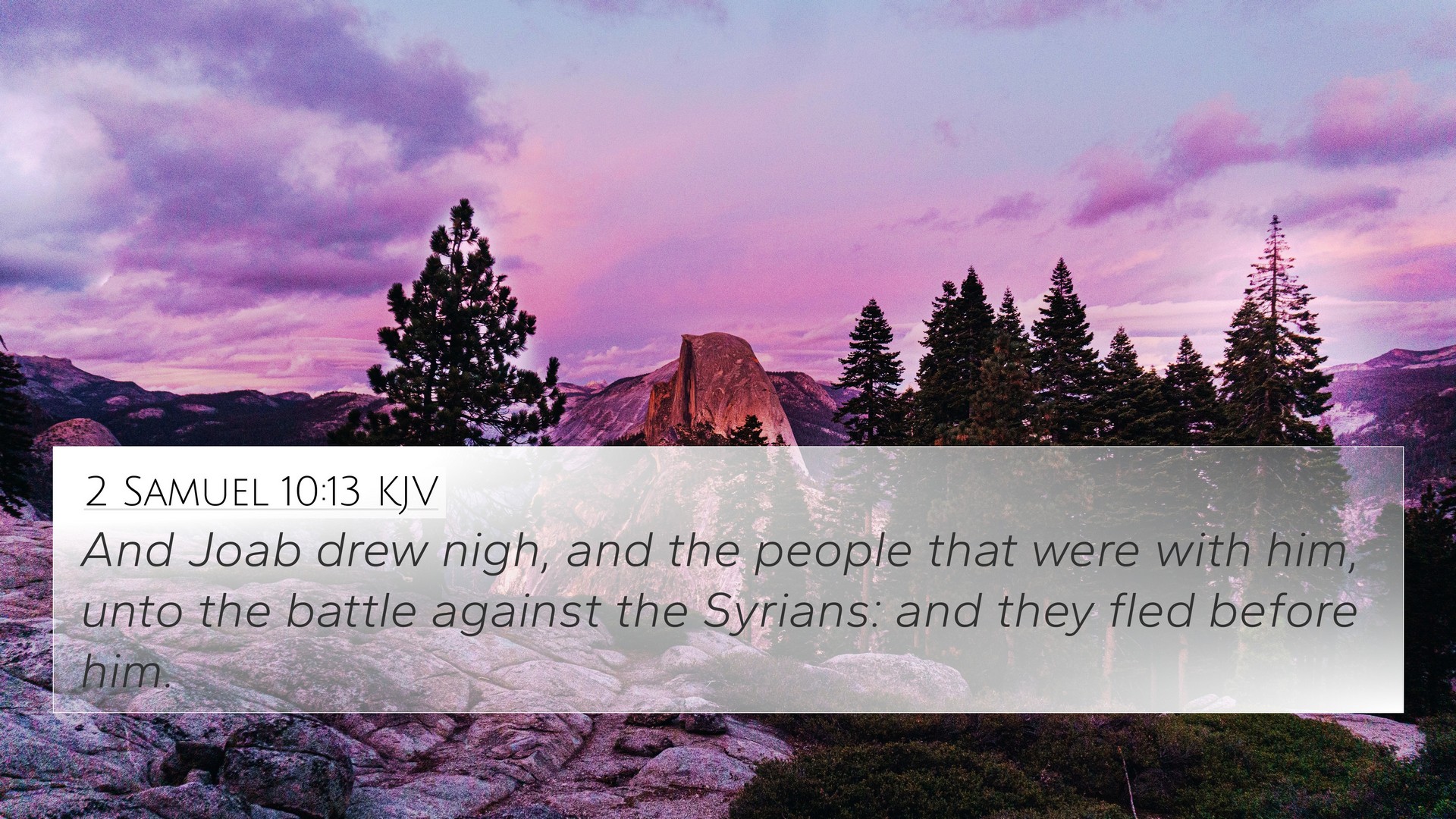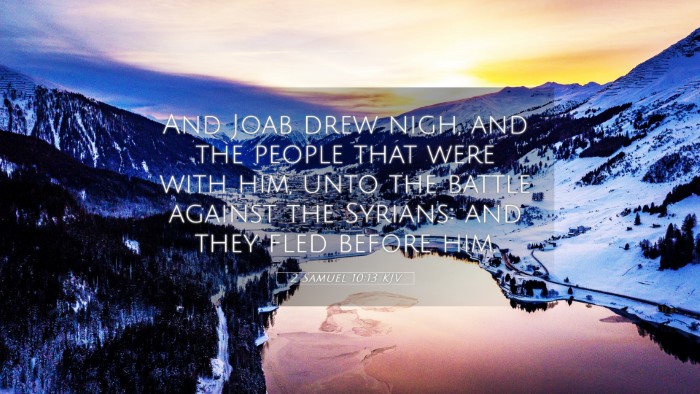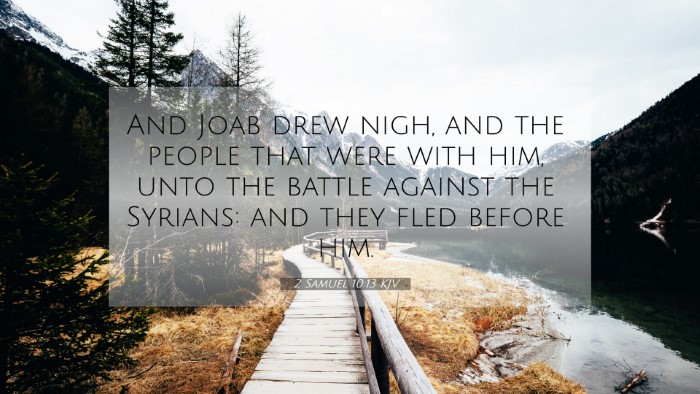Old Testament
Genesis Exodus Leviticus Numbers Deuteronomy Joshua Judges Ruth 1 Samuel 2 Samuel 1 Kings 2 Kings 1 Chronicles 2 Chronicles Ezra Nehemiah Esther Job Psalms Proverbs Ecclesiastes Song of Solomon Isaiah Jeremiah Lamentations Ezekiel Daniel Hosea Joel Amos Obadiah Jonah Micah Nahum Habakkuk Zephaniah Haggai Zechariah Malachi2 Samuel 10:13 Similar Verses
2 Samuel 10:13 Cross References
And Joab drew nigh, and the people that were with him, unto the battle against the Syrians: and they fled before him.
Uncover the Rich Themes and Topics of This Bible Verse
Listed below are the Bible themes associated with 2 Samuel 10:13. We invite you to explore each theme to gain deeper insights into the Scriptures.
2 Samuel 10:13 Cross Reference Verses
This section features a detailed cross-reference designed to enrich your understanding of the Scriptures. Below, you will find carefully selected verses that echo the themes and teachings related to 2 Samuel 10:13 KJV. Click on any image to explore detailed analyses of related Bible verses and uncover deeper theological insights.
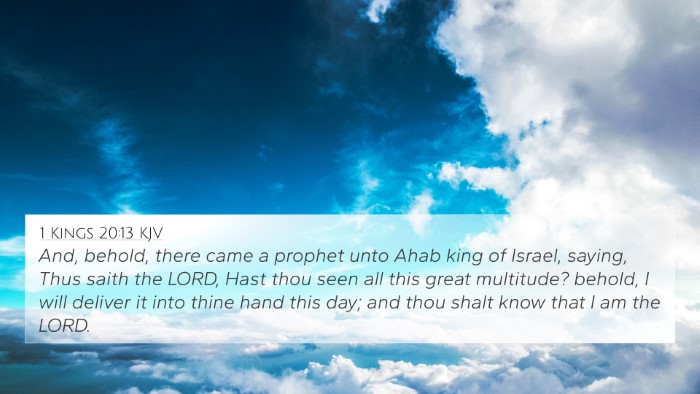
1 Kings 20:13 (KJV) »
And, behold, there came a prophet unto Ahab king of Israel, saying, Thus saith the LORD, Hast thou seen all this great multitude? behold, I will deliver it into thine hand this day; and thou shalt know that I am the LORD.
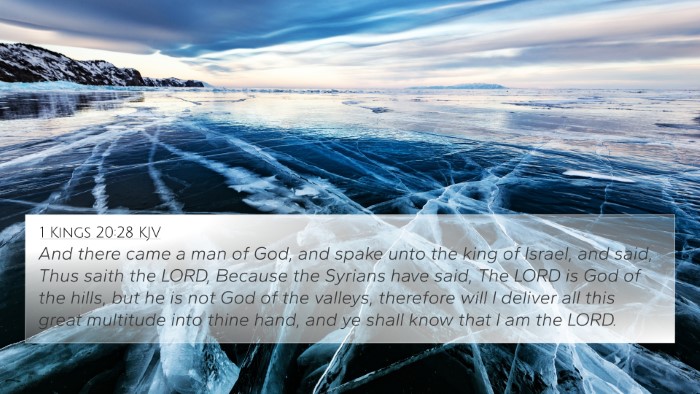
1 Kings 20:28 (KJV) »
And there came a man of God, and spake unto the king of Israel, and said, Thus saith the LORD, Because the Syrians have said, The LORD is God of the hills, but he is not God of the valleys, therefore will I deliver all this great multitude into thine hand, and ye shall know that I am the LORD.
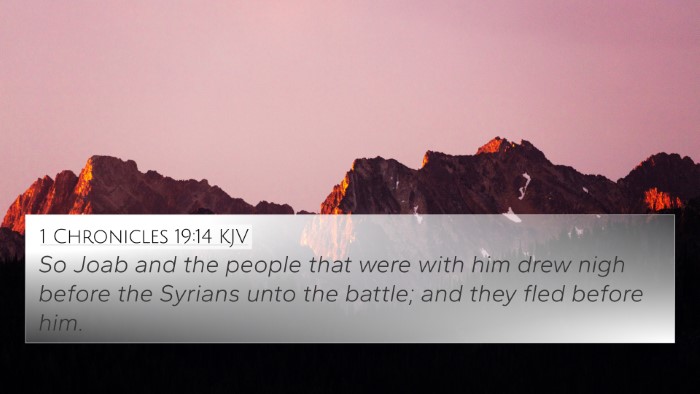
1 Chronicles 19:14 (KJV) »
So Joab and the people that were with him drew nigh before the Syrians unto the battle; and they fled before him.
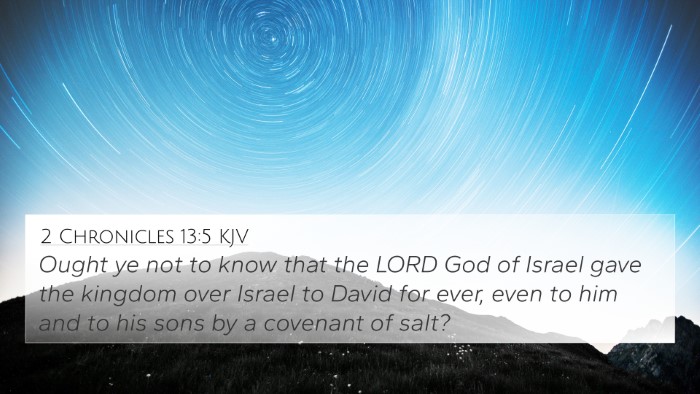
2 Chronicles 13:5 (KJV) »
Ought ye not to know that the LORD God of Israel gave the kingdom over Israel to David for ever, even to him and to his sons by a covenant of salt?
2 Samuel 10:13 Verse Analysis and Similar Verses
Understanding 2 Samuel 10:13
Verse: "So Joab and the people who were with him drew near to battle against the Arameans, and they fought against them."
Contextual Analysis
In this verse, we find Joab, the commander of King David's army, leading his troops into battle against the Arameans. This event comes after the death of Hanun's father, when David sends envoys of condolence, which were misinterpreted, leading to conflict.
Insights from Commentaries
-
Matthew Henry: Henry notes the significance of Joab's leadership and the courage shown by the Israelites. He emphasizes that facing opposition is a necessary aspect of faith, and the Lord's support accompanies those who fight in righteousness.
-
Albert Barnes: Barnes comments on the strategies employed in the battle, highlighting the tactical decisions made by Joab. He points out that the battle serves as a reminder of the importance of strength in unity among believers when facing adversity.
-
Adam Clarke: Clarke provides historical context, detailing the animosity between Israel and the Arameans. His analysis indicates that this conflict is part of a larger narrative of Israel's struggles and divine interventions throughout their history.
Thematic Connections
This verse relates to several themes found throughout the Bible, such as:
- Military conflict as a metaphor for spiritual warfare.
- The leadership qualities exhibited by Joab, paralleling other Biblical leaders.
- The concept of divine support in times of battle, echoed in the New Testament.
Cross-References
This verse can be linked to the following Bible verses for further study:
- 1 Chronicles 19:11-12: This passage recounts a similar battle against the Ammonites and Arameans, providing a detailed account of Joab's military tactics.
- 2 Samuel 8:5: A reference to David's military campaigns and victories over the same region, emphasizing God's hand in battles.
- Psalms 20:7: This verse discusses trusting in God rather than reliance on earthly power, reflecting the principles that guide leaders like Joab.
- 2 Chronicles 32:7-8: Hezekiah’s declaration of faith in the face of Assyrian threats mirrors Joab’s determination in battle.
- Ephesians 6:12: The idea of wrestling not against flesh and blood resonates deeply when considering the spiritual implications of physical battles in the Old Testament.
- 1 Timothy 6:12: The charge to fight the good fight of faith aligns with Joab's role as a leader in battle.
- Philippians 1:28: The call for believers to stand firm in the face of opposition serves as a reminder of the New Testament's connection to these Old Testament stories.
Comparative Analysis
By examining 2 Samuel 10:13 in conjunction with the above verses, we find:
Leadership Qualities: Both Joab and other biblical leaders exhibit courage and strategic planning.
God's Sovereignty: A continuous theme that God's purpose prevails amidst human conflict.
Trust in God: Encouragement for believers to maintain faith during personal and communal trials.
Tools for Bible Cross-Referencing
Utilizing the following tools can enhance your understanding of inter-Biblical connections:
- Bible Concordance: An invaluable resource for locating similar themes and verses.
- Cross-reference Bible Study Guide: Guides that systematically link related verses.
- Comprehensive Cross-reference Materials: Collections designed to provide extensive verse connections.
Application Today
Modern readers of 2 Samuel 10:13 can draw parallels to personal and communal battles faced in life. Just as Joab led with courage, believers are called to stand firm in their faith amid challenges, supported by divine assurance and the fellowship of fellow believers.
Conclusion
2 Samuel 10:13 serves as a powerful reminder of the faithfulness of God in times of conflict and the importance of strong leadership. By cross-referencing this scripture with related passages, one can better understand both the historical context and the spiritual truths that transcend time.
